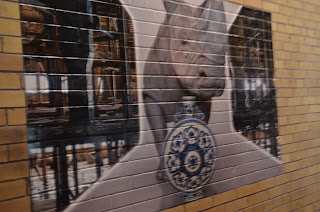This the Hearn, a building that opened as a power generating plant in 1953. At one time this was one of the largest buildings in North America. You could take the Statue of Liberty and lay it down inside the structure. It was coal burning back then, later converted to natural gas but it was always just a machine, and despite a couple of Art Deco touches at the entrance, this place was never designed to influence art.
And yet, it has
Luminato is an art festival that this year, celebrated its tenth anniversary. They wanted to do something special to further that celebration and indeed they have. They opened up the Hearn, this functional machine and not only did they make it a place that hosted art they have, in a way, made it into art itself
It was no easy undertaking. The Hearn, still owned by the Ontario government, has been vacated since 1983. Some "urban explorers" and photographers over the years have ventured into the Hearn, sending back pictures of vast huge galleries defined by arches that seemed to have a Mayan influence, and huge spaces, now empty of their machinery, guarded by girders stretching up hundreds of feet
The place was not safe. Bare dirt floors and broken windows and darkness that concealed sharp angles and steel shards, cables and wires coiled underfoot and pools of water that were still and glossy as ancient black glass
The people at Luninato did a hell of a job, building walkways, installing an elevator, creating theatres and lounges and even a restaurant. They had to pour cement down on the main floor to provide people with safe passage.
It's an interesting concept, converting this entirely prosaic building into a place for art and music and theatre. They staged plays here, and concerts and discussions about the nature of art. There were art installations of course, and they went the way that these kinds of installations go, sometimes interesting, oft times just ... odd
One of the more successful installations was Trove, a series of images painted onto the walls of the Hearn's upper gallery, reflecting the location, the neighbourhood and the history of the area as it moved from industry to re-gentrification
Then, there was the disco ball. Yup, a mirror disco ball. A huge one, suspended from the Hearn's ceiling. And revolving. Well, of course revolving, what kind of disco ball does not spin. When I first saw it the first thought was "How the hell did they get that thing up there" and the second thought simply was "Why"
But as the thing spun, its reflections moved across the vast spaces of the Hearn. Whimsical shapes, organic, flowed across the girders and arches and walls, as if they were alive, aquatic shapes you could say, moving silently, slowly, chimerical lights floating in a place that had never been intended to host such whimsy
That was the beauty of the whole thing, the Hearn became its own work of art, it was transformed by the art that had been installed within it. It was pretty amazing experience, to walk in this place where we had never been intended to walk, to view the art that should never have been placed here, to experience something that had been abandoned, become something alive
There was also something alive just outside the Hearn. In a tiny clearing surrounded by waist high weeds, behind a chain link fence, a human figure reposed on a bench. Not a human of course but a sculpture, rather Greek in its proportions and attitude. What was not Greek was the statue's head. A bee hive. With real bees surrounding it. Another example of combining something organic with something artifical
The song that I chose for my video is Conquest of Spaces by Yoann Lemoine who records music under the name Woodkid. In part, the song says "Beyond the laws of density, Towers of glass and steel, Temples and fragments of memories, Drifting away from me" Very appropriate. And more art, in a place where art was never meant to be.























